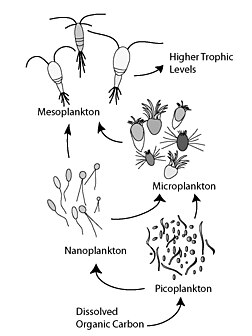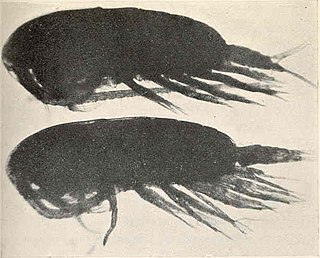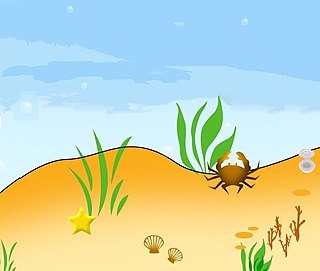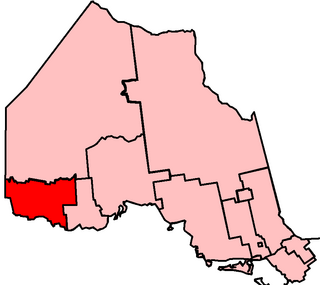Related Research Articles

Zooplankton are heterotrophic plankton. Plankton are organisms drifting in oceans, seas, and bodies of fresh water. The word zooplankton is derived from the Greek zoon (ζῴον), meaning "animal", and planktos (πλαγκτός), meaning "wanderer" or "drifter". Individual zooplankton are usually microscopic, but some are larger and visible to the naked eye.

The microbial loop describes a trophic pathway where, in aquatic systems, dissolved organic carbon (DOC) is returned to higher trophic levels via its incorporation into bacterial biomass, and then coupled with the classic food chain formed by phytoplankton-zooplankton-nekton. In soil systems, the microbial loop refers to soil carbon. The term microbial loop was coined by Farooq Azam, Tom Fenchel et al. in 1983 to include the role played by bacteria in the carbon and nutrient cycles of the marine environment.
Polymictic lakes are holomictic lakes that are too shallow to develop thermal stratification; thus, their waters can mix from top to bottom throughout the ice-free period. Polymictic lakes can be divided into cold polymictic lakes, and warm polymictic lakes. While such lakes are well-mixed on average, during low-wind periods, weak and ephemeral stratification can often develop.
A chemocline is a type of cline, a layer of fluid with different properties, characterized by a strong, vertical chemistry gradient within a body of water. In bodies of water where chemoclines occur, the cline separates the upper and lower layers, resulting in different properties for those layers. The lower layer shows a change in the concentration of dissolved gases and solids compared to the upper layer.

Calanus finmarchicus is a species of copepods and a part of zooplankton, which is found in enormous amounts in the northern Atlantic Ocean.

In physical oceanography, Langmuir circulation consists of a series of shallow, slow, counter-rotating vortices at the ocean's surface aligned with the wind. These circulations are developed when wind blows steadily over the sea surface. Irving Langmuir discovered this phenomenon after observing windrows of seaweed in the Sargasso Sea in 1927. Langmuir circulations circulate within the mixed layer; however, it is not yet so clear how strongly they can cause mixing at the base of the mixed layer.

Gelatinous zooplankton are fragile animals that live in the water column in the ocean. Their delicate bodies have no hard parts and are easily damaged or destroyed. Gelatinous zooplankton are often transparent. All jellyfish are gelatinous zooplankton, but not all gelatinous zooplankton are jellyfish. The most commonly encountered organisms include ctenophores, medusae, salps, and Chaetognatha in coastal waters. However, almost all marine phyla, including Annelida, Mollusca and Arthropoda, contain gelatinous species, but many of those odd species live in the open ocean and the deep sea and are less available to the casual ocean observer. Many gelatinous plankters utilize mucous structures in order to filter feed. Gelatinous zooplankton have also been called "Gelata".
The G. Evelyn Hutchinson Award is an award granted annually by the Association for the Sciences of Limnology and Oceanography to a mid-career scientist for work accomplished during the preceding 5–10 years for excellence in any aspect of limnology or oceanography. The award is named in honor of the ecologist and limnologist G. Evelyn Hutchinson. Hutchinson requested that recipients of the award have made considerable contributions to knowledge, and that their future work promise a continuing legacy of scientific excellence.

Particulate organic matter (POM) is a fraction of total organic matter operationally defined as that which does not pass through a filter pore size that typically ranges in size from 0.053 to 2 millimeters.

The viral shunt is a mechanism that prevents marine microbial particulate organic matter (POM) from migrating up trophic levels by recycling them into dissolved organic matter (DOM), which can be readily taken up by microorganisms. The DOM recycled by the viral shunt pathway is comparable to the amount generated by the other main sources of marine DOM.
The Black Queen hypothesis (BQH) is reductive evolution theory which seeks to explain how natural selection can drive gene loss. In a microbial community, different members may have genes which produce certain chemicals or resources in a "leaky fashion" making them accessible to other members of that community. If this resource is available to certain members of a community in a way that allows them to sufficiently access that resource without generating it themselves, these other members in the community may lose the biological function involved in producing that chemical. Put another way, the black queen hypothesis is concerned with the conditions under which it is advantageous to lose certain biological functions. By accessing resources without the need to generate it themselves, these microbes conserve energy and streamline their genomes to enable faster replication.

Benthic-pelagic coupling are processes that connect the benthic zone and the pelagic zone through the exchange of energy, mass, or nutrients. These processes play a prominent role in both freshwater and marine ecosystems and are influenced by a number of chemical, biological, and physical forces that are crucial to functions from nutrient cycling to energy transfer in food webs.

The shoreline development index of a lake is the ratio of the length of the lake's shoreline to the circumference of a circle with the same area as the lake. It is given in equation form as , where is shoreline development, is the length of the lake's shoreline, and is the lake's area. The length and area should be measured in the units. The shoreline development index is for perfectly circular lakes. for lakes with complex shapes.
Yvette Hardman Edmondson was the editor of Limnology and Oceanography the premier journal of the Association for the Sciences of Limnology and Oceanography and was an aquatic scientist known for her research on bacteria in aquatic systems.
Sherilyn Fritz is known for her research on paleoclimate and paleoecology, with a particular focus on the use of diatoms to reconstruct past environmental conditions.

Lake 227 is one of 58 lakes located in the Experimental Lakes Area (ELA) in the Kenora District of Ontario, Canada. Lake 227 is one of only 5 lakes in the Experimental Lakes Area currently involved in long-term research projects, and is of particular note for its importance in long term lake eutrophication studies. The relative absence human activity and pollution makes Lake 227 ideal for limnological research, and the nature of the ELA makes it one of the only places in the world accessible for full lake experiments. At its deepest, Lake 227 is 10 meters deep, and the area of the lake is approximately 5 hectares. Funding and governmental permissions for access to Lake 227 have been unstable in recent years, as control of the ELA was handed off by the Canadian government to the International Institute for Sustainable Development (IISD).
Patricia Marguerite Glibert is marine scientist known for her research on nutrient use by phytoplankton and harmful algal blooms in Chesapeake Bay. She is an elected fellow of the American Association for the Advancement of Science.
Margaret Ruth Mulholland is professor at Old Dominion University known for her work on nutrients in marine and estuarine environments.
Elizabeth A. Canuel is a chemical oceanographer known for her work on organic carbon cycling in aquatic environments. She is the Chancellor Professor of Marine Science at the College of William & Mary and is an elected fellow of the Geochemical Society and the European Association of Geochemistry.
Kendra Lee Daly is an oceanographer known for her work on zooplankton, particularly in low oxygen regions of the ocean. She is a professor at the University of South Florida, and an elected fellow of the American Association for the Advancement of Science.
References
- ↑ Hairston, Nelson G. (July 1996). "Zooplankton egg banks as biotic reservoirs in changing environments". Limnology and Oceanography. 41 (5): 1087–1092. Bibcode:1996LimOc..41.1087H. doi: 10.4319/lo.1996.41.5.1087 . ISSN 0024-3590.
- 1 2 3 Kerfoot, W. Charles; Robbins, John A.; Weider, Lawrence J. (July 1999). "A new approach to historical reconstruction: Combining descriptive and experimental paleolimnology". Limnology and Oceanography. 44 (5): 1232–1247. Bibcode:1999LimOc..44.1232K. doi:10.4319/lo.1999.44.5.1232. ISSN 0024-3590. S2CID 11436470.
- ↑ Hairston, N. G.; Holtmeier, C. L.; Lampert, W.; Weider, L. J.; Post, D. M.; Fischer, J. M.; Cáceres, C. E.; Fox, J. A.; Gaedke, U. (2001). "Natural Selection for Grazer Resistance to Toxic Cyanobacteria: Evolution of Phenotypic Plasticity?". Evolution. 55 (11): 2203–2214. doi: 10.1111/j.0014-3820.2001.tb00736.x . ISSN 0014-3820. PMID 11794781. S2CID 10130103.
- 1 2 Kerfoot, W. Charles; Weider, Lawrence J. (2004). "Experimental paleoecology (resurrection ecology): Chasing Van Valen's Red Queen hypothesis". Limnology and Oceanography. 49 (4part2): 1300–1316. Bibcode:2004LimOc..49.1300K. doi: 10.4319/lo.2004.49.4_part_2.1300 . ISSN 0024-3590.
- ↑ Cousyn, C.; De Meester, L.; Colbourne, J. K.; Brendonck, L.; Verschuren, D.; Volckaert, F. (2001). "Rapid, local adaptation of zooplankton behavior to changes in predation pressure in the absence of neutral genetic changes". Proceedings of the National Academy of Sciences. 98 (11): 6256–6260. Bibcode:2001PNAS...98.6256C. doi: 10.1073/pnas.111606798 . ISSN 0027-8424. PMC 33455 . PMID 11353872.